Sustainable Management of Very Large Trees with the Use of Acoustic Tomography
Abstract
:1. Introduction
Protection of Natural Heritage Resources in Poland—Natural Monuments
- Replacement, planting near a young tree—e.g., the “Copernicus oak” in the courtyard of the Cathedral in Frombork,
- Conservation of tree trunk—e.g., the elm in front of Pawiak in Warsaw. After decay, the stump was preserved for many years, and then a bronze monument was made,
- Using parts of a rotten trunk—as sculptures,
- Leaving the tree standing, for example, as the frame for creepers,
- Leaving the tree lying down,
- Ex situ protection of remains—transfer of trunk fragments for a museum, e.g., with the dates of historical events marked on a cross-section.
2. Materials and Methods
3. Results
3.1. Objects and Reasons for Tomograph Examination
3.2. Characteristics of Threats to Very Large Trees
4. Discussion—Tomograph as a Tool Supporting the Management of Historical Greenery
5. Conclusions
Author Contributions
Funding
Institutional Review Board Statement
Informed Consent Statement
Data Availability Statement
Acknowledgments
Conflicts of Interest
References
- Anielska, K. Rola terenów zieleni miejskiej w zrównoważonym rozwoju miasta na przykładzie Nowej Huty. Zarządzanie Publiczne 2013, 1, 59–76. [Google Scholar] [CrossRef] [Green Version]
- Gyurkovich, K. Znaczenie Form Charakterystycznych dla Kształtowania i Percepcji Przestrzeni: Wybrane Zagadnienia Kompozycji w Architekturze i Urbanistyce; Wyd. Politechnika Krakowska: Kraków, Poland, 1999. [Google Scholar]
- Paszkowski, Z. Miasto Idealne w Perspektywie Europejskiej i Jego Związki z Urbanistyką Współczesną; Wyd. Towarzystwo Autorów i Wydawców Prac Naukowych Universitas: Kraków, Poland, 2012. [Google Scholar]
- Oliveira, V.; Mafalda, S.; Ivor, S. Urban morphological research and planning practice: A Portuguese assessment. Urban Morphol. 2014, 18, 23–39. [Google Scholar]
- Chiesura, A. The role of urban parks for the sustainable city. Landsc. Urban Plan. 2004, 68, 129–138. [Google Scholar] [CrossRef]
- Berman, M.G.; Jonides, J.; Kaplan, S. The cognitive benefits of interacting with nature. Psychol. Sci. 2008, 19, 1207–1212. [Google Scholar] [CrossRef] [PubMed]
- Aronson, M.; Lepczyk, C.; Evans, K.; Goddard, M.; Lerman, S.; MacIvor, S.; Nilon, C.; Vargo, T. Biodiversity in the city: Key challenges for urban green space management. Front. Ecol. Environ. 2017, 15, 1–8. [Google Scholar] [CrossRef] [Green Version]
- Irvine, K.N.; Devine-Wright, P.; Payne, S.R.; Fuller, R.A.; Painter, B.; Gaston, K.J. Green space, soundscape and urban sustainability: An interdisciplinary, empirical study. Local Environ. Int. 2009, 14. [Google Scholar] [CrossRef]
- Bowler, D.E.; Buyung-Ali, L.; Knight, T.M.; Pullin, A.S. Urban greening to cool towns and cities: A systematic review of the empirical evidence. Landsc. Urban Plan. 2010, 97, 147–155. [Google Scholar] [CrossRef]
- Bastian, O.; Haase, D.; Grunewald, K. Ecosystem properties, potentials and services—The EPPS conceptual framework and an urban application example. Ecol. Indic. 2012, 21, 7–16. [Google Scholar] [CrossRef]
- Jansson, M. Green space in compact cities: The benefits and values of urban ecosystem services in planning. Nord. J. Archit. Res. 2014, 2, 139–160. [Google Scholar]
- Goddard, M.; Dougill, A.; Benton, T. Scaling up from gardens: Biodiversity conservation in urban environments. Trends Ecol. Evol. 2010, 25, 90–98. [Google Scholar] [CrossRef] [PubMed]
- Kaneko, N.; Yoshiura, S.; Kobayashi, M. Sustainable Living with Environmental Risks; Springer Science & Business Media: Berlin/Heidelberg, Germany, 2014; 286p. [Google Scholar]
- Beninde, J.; Veith, M.; Hochkirch, A. Biodiversity in cities needs space: A meta- analysis of factors determining intra- urban biodiversity variation. Ecol. Lett. 2015, 18, 581–592. [Google Scholar] [CrossRef]
- Ramos-Rivera, J.; Rahardjo, H.; Tsen-Tieng, D.L.; Xuefeng, N.; King, F.Y. Mechanical response of the real tree root architecture under lateral load. Can. J. For. Res. 2020, 50. [Google Scholar] [CrossRef]
- Grzywacz, A. Drzewa pomniki przyrody świata i Polski. Agricola 2001, 51, 29–41. [Google Scholar]
- Grzywacz, A. Drzewa w krajobrazie kulturowym. Zarządzanie Ochr. Przyr. W Lasach 2011, 5, 245–259. [Google Scholar]
- Siewniak, M. Ochrona drzew pomnikowych. Komun. Dendrol. 1988, 7, 1–15. [Google Scholar]
- Kasprzak, K. Ochrona Pomników Przyrody; Zasady Postępowania Administracyjnego ABRYS: Poznań, Poland, 2005. [Google Scholar]
- Pietrzak, J. Problemy ochrony drzew i krzewów pomnikowych w Polsce. Zarządzanie Ochroną Przyrody w Lasach 2010, 4, 283–300. [Google Scholar]
- Pietrzak-Zawadka, J. Drzewa-Pomniki Przyrody Elementem Funkcji Turystycznej Obszaru [w:] Jalinik Mikołaj; Bakier, S., Ed.; Obszary przyrodniczo cenne w rozwoju turystyki: Oficyna Wydawnicza Politechniki Białostockiej: Białystok, Poland, 2020; pp. 114–125. [Google Scholar]
- Central Statistical Office. Data on Natural Monuments. Available online: https://bdl.stat.gov.pl/BDL/metadane/cechy/1660?back=True (accessed on 29 May 2021).
- Ustawa z dnia 16 kwietnia 2004 r. o ochronie przyrody, Dz. U. z 2004 r., Nr 92 poz. 880. Available online: https://isap.sejm.gov.pl/isap.nsf/DocDetails.xsp?id=WDU20040920880 (accessed on 29 May 2021).
- Dudkiewicz, M.; Durlak, W.; Dąbski., M.; Iwanek, M.; Jarosz, Z.; Patro, K. Możliwość zastosowania gatunków obcego pochodzenia w rewitalizacji obiektów zabytkowych na podstawie występowania drzew pomnikowych. Annales Universitatis Mariae Curie-Sklodowska Sectio EEE Horticultura 2016, 26, 1–17. [Google Scholar]
- Durlak, W.; Dudkiewicz, M.; Pudelska, K.; Dąbski, M. Zastosowanie tomografii komputerowej w badaniach kondycji drzew zieleni publicznej [w:]. In Roślinność Pasów Przydrożnych Lublina—Potencjał i Zagrożenia; Trzaskowska, E., Ed.; Urząd Miasta Lublin: Lublin, Poland, 2017; pp. 237–246. [Google Scholar]
- Karlinasari, L.; Lestarni, A.T.; Nanabar, M.Y.S.; Siregar, I.Z. Assessment of urban tree condition using sonic tomography technology. In Proceedings of the IOP Conference Series: Earth and Environmental Science, Banda Aceh, Indonesia, 26–27 September 2018. [Google Scholar] [CrossRef]
- Konijnendijk, C.; Nilsson, K.; Randrup, T.B.; Schipperijn, J. (Eds.) Urban Forests and Trees; Springer: Berlin/Heidelberg, Germany, 2015. [Google Scholar]
- Kane, B.; Ryan, D.; Bloniarz, D.V. Comparing formula that assess strength lossdue to decay in trees. J. Arboric. 2001, 27, 78–87. [Google Scholar]
- Hayes, E. Tree Risk Assessment & Tree Mechanics. Arborist News 2002, 6, 33–39. [Google Scholar]
- Suchocka, M. Zalety i ograniczenia stosowania wizualnej metody oceny drzew (VTA) jako odpowiedź na problemy związane z zagrożeniami powodowanymi przez drzewa miejskie. Człowiek I Sr. 2012, 36, 97–110. [Google Scholar]
- Mattheck, C.; Bethge, K.; Weber, K. The body language of trees. In Encyclopedia of Visual Tree Assessment; Karlsruhe Institute of Technology—Campus North: Karlsruhe, Germany, 2015; pp. 404–405. [Google Scholar]
- Hayes, E. Evaluating Tree Defects; Safetrees: Rochester, MN, USA, 2001; 34p. [Google Scholar]
- Pokorny, J. Urban Tree Risks Management: A Community Guide to Program Design and Implementation; NA-TP-03-03; USDA Forest Service, Northeastern Area, State and Private Forestry: St. Paul, MN, USA, 2003; 194p. [Google Scholar]
- Luley, C.L. Wood Decay Fungi Common to Living Urban Trees in the Northeast and Central United States; Urban Forestry LLC: Naples, NY, USA, 2003; 61p. [Google Scholar]
- Wang, X.; Allison, R.B. Decay detection in red oak trees using a combination of visual inspection, acoustic testing, and resistance microdrilling. Arboric. Urban For. 2008, 34, 1–4. [Google Scholar]
- Chomicz, E. Bezinwazyjne metody wykrywania defektów wewnątrz pni drzew stojących (Tomograf PiCUS® Sonic i PiCUS® Treetronic). Leśne Prace Badawcze 2007, 3, 117–121. [Google Scholar]
- Chomicz, E. Bezinwazyjne diagnozowanie kondycji drzew zabytkowych z zastosowaniem tomografów PiCUS®. Kurier Konserwatorski 2010, 8, 29–32. [Google Scholar]
- Siewniak, M. Pielęgnowanie drzew —Dzisiaj. Kurier Konserwatorski 2010, 8, 24–28. [Google Scholar]
- Göcke, L.; Rust, S.; Weihs, U.; Günther, T.; Rücker, C. Combining sonic and electrical impedance tomography for the nondestructive testing of trees. In Proceedings of the 15th International Symposium on Nondestructive Testing of Wood, Duluth, MN, USA, 10–12 September 2007; pp. 31–42. [Google Scholar]
- Nicolotti, G.; Socco, L.V.; Martinis, R.; Godio, A.; Sambuelli, L. Application and comparison of three tomographic techniques for detection of decay in trees. J. Arboric. 2003, 29, 66–77. [Google Scholar]
- Rinn, F. Central defects in sonic tree tomography. West. Arborist 2016, 1, 39–41. [Google Scholar]
- Rinn, F. Central Basics of Sonic Tree Tomography. Available online: http://ictinternational.com/content/uploads/2015/02/RINN_SonicTreeTomography_SCAToday12_2014.pdf (accessed on 29 May 2021).
- Gilbert, E.A.; Smiley, E.T. Picus Sonic Tomography for the quantification of decay in white oak (Quercus alba) and hickory (Carya spp.). J. Arboric. 2004, 30, 277–281. [Google Scholar]
- Rabe, C.; Ferner, D.; Fink, S.; Schwarze, F. Detection of decay in trees with stress waves and interpretation of acoustic tomograms. J. Arboric. 2004, 28, 3–19. [Google Scholar] [CrossRef]
- Deflorio, G.; Fink, S.; Schwarze, F. Detection of incipient decay in tree stems with sonic tomography after wounding and fungal inoculation. Wood Sci. Technol. 2008, 42, 117–132. [Google Scholar] [CrossRef]
- Li, G.; Wang, X.; Feng, H.; Wiedenbeck, J.; Ross, R.J. Analysis of wave velocity patterns in black cherry trees and its effect on internal decay detection. Comput. Electron. Agric. 2014, 104, 32–39. [Google Scholar] [CrossRef]
- Espinosa, L.; Arciniegas, A.; Cortes, Y. Automatic segmentation of acoustic tomography images for the measurement of wood decay. Wood Sci. Technol. 2017, 51, 69–84. [Google Scholar] [CrossRef]
- Pereira, L.F.A.; Janssens, E.; Cavalcanti, G.D.C.; Ren, T.I.; Dael, M.V.; Verboven, P.; Nicola, B.; Sijbers, J. Inline discrete tomography system: Application to agricultural product inspection. Comput. Electron. Agric. 2017, 138, 117–126. [Google Scholar] [CrossRef]
- Liu, L.; Li, G. Acoustic tomography based on hybrid wave propagation model for tree decay detection. Comput. Electron. Agric. 2018, 151, 276–285. [Google Scholar] [CrossRef]
- Qiu, Q.; Qin, R.; Lam, J.; Tang, A.; Leung, M.; Lau, D. An innovative tomographic technique integrated with acoustic-laser approach for detecting defects in tree trunk. Comput. Electron. Agric. 2019, 156, 129–137. [Google Scholar] [CrossRef]
- Rinn, F. Technische Grundlagen der Impuls-Tomographie. Baumzeitung 2003, 8, 29–31. [Google Scholar]
- Rinn, F. Holzanatomische Grundlagen der Schall-Tomographie an Bäumen. Neue Landschaft 2004, 7, 44–47. [Google Scholar]
- Rinn, F. Basics of typical resistance-drilling profiles. Western Arborist. Winter 2012, 4, 30–36. [Google Scholar]
- Rinn, F. Detecting fungal decay in palm stems by resistance drilling. Florida Arborist. Spring + Summer 2013. Available online: http://www.ictinternational.com/casestudies/detecting-fungal-decay-in-palm-stems-by-resistance-drilling/ (accessed on 29 May 2021).
- Simon, J.; Machar, I.; Brus, J.; Pechanec, V. Combining a growth-simulation model with acoustic-wood tomography as a decision-support tool for adaptive management and conservation of forest ecosystems. Ecol. Inform. 2015, 30, 309–312. [Google Scholar] [CrossRef]
- Son, J.; Lee, G.; Shin, J. Reliability of Noninvasive Sonic Tomography for the Detection of Internal Defects in Old, Large Trees of Abies holophylla Maxim. Forests 2021, 8, 1131. [Google Scholar] [CrossRef]
- Dudkiewicz, M.; Durlak, W. Sonic Tomograph as a Tool Supporting the Sustainable Management of Historical Greenery of the UMCS Botanical Garden in Lublin. Sustainability 2021, 13, 9451. [Google Scholar] [CrossRef]
- United States Department of Agriculture. A Guide to Identifying, Assessing, and Managing Hazard Trees in Developed Recreational Sites of the Northern Rocky Mountains and the Intermountain West; United States Department of Agriculture: Chester, MT, USA, 2017. [Google Scholar]
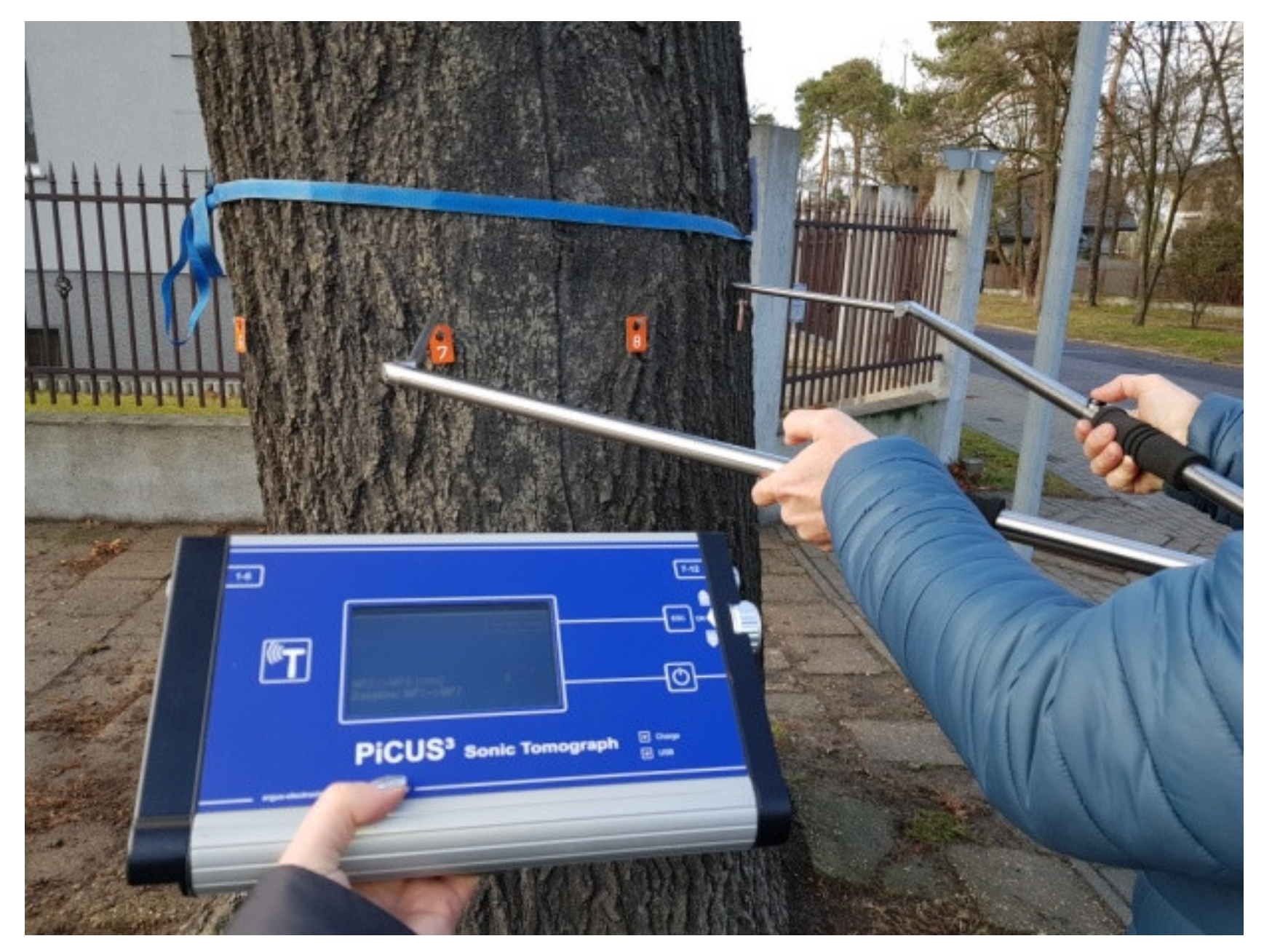

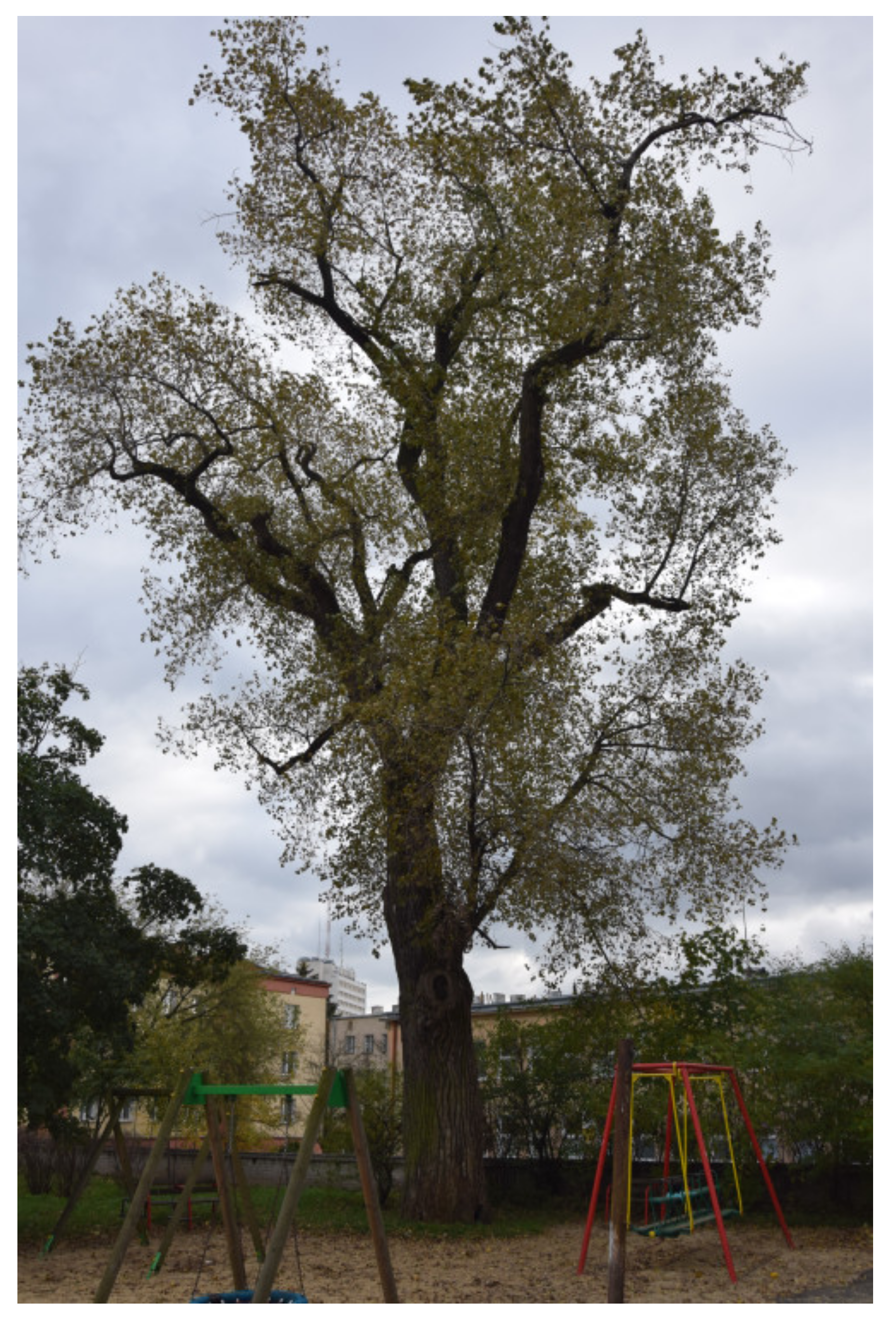



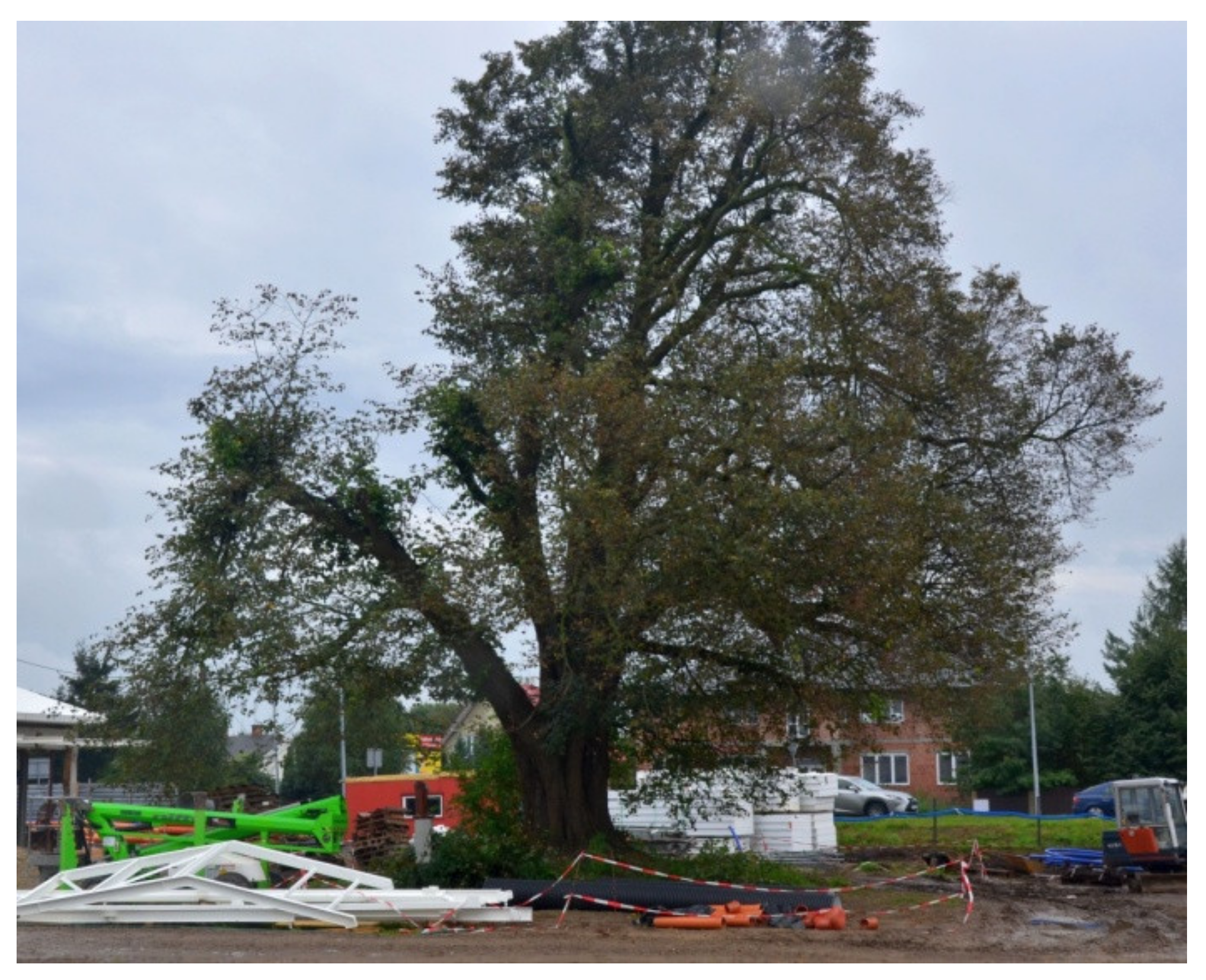

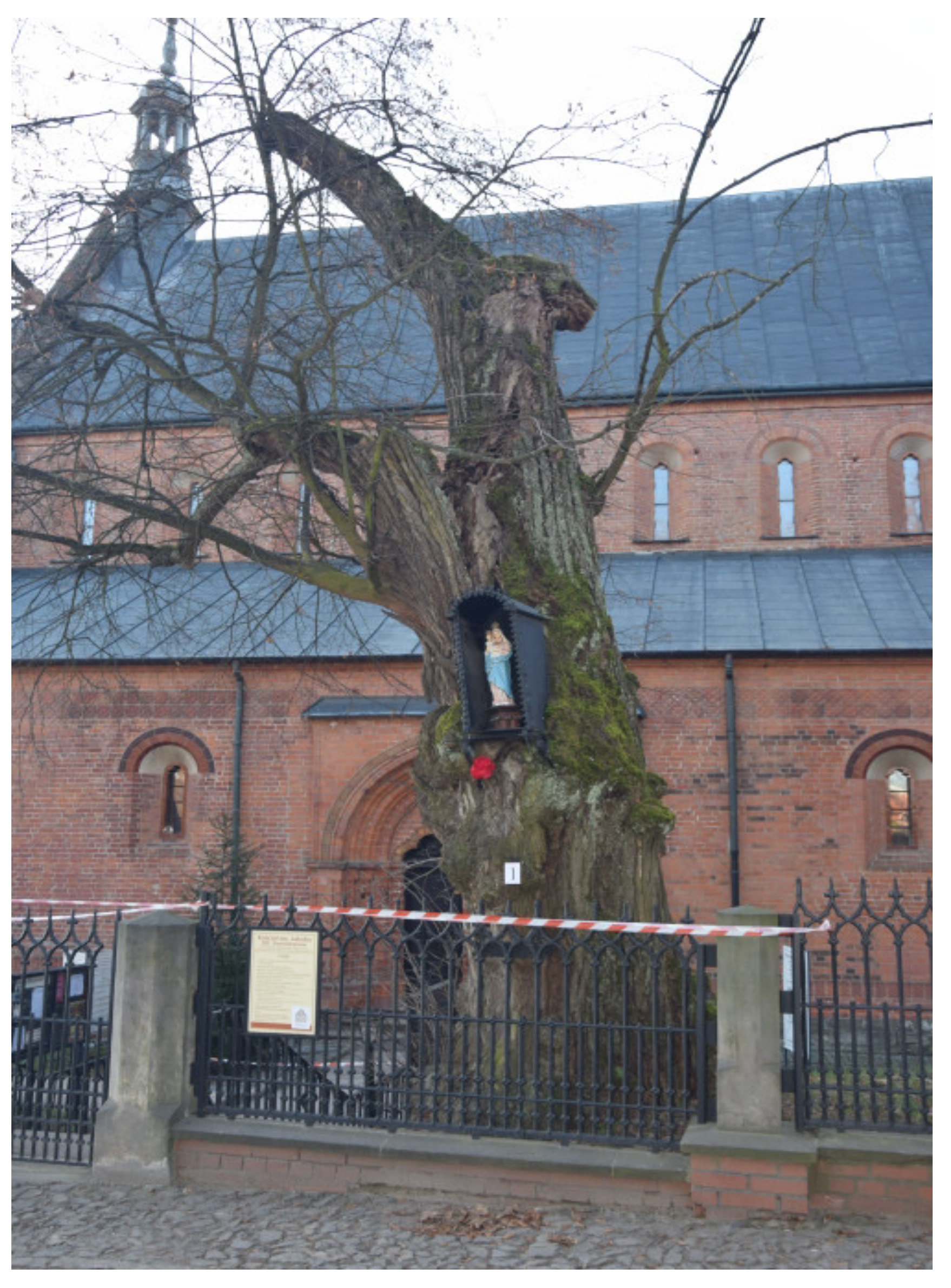
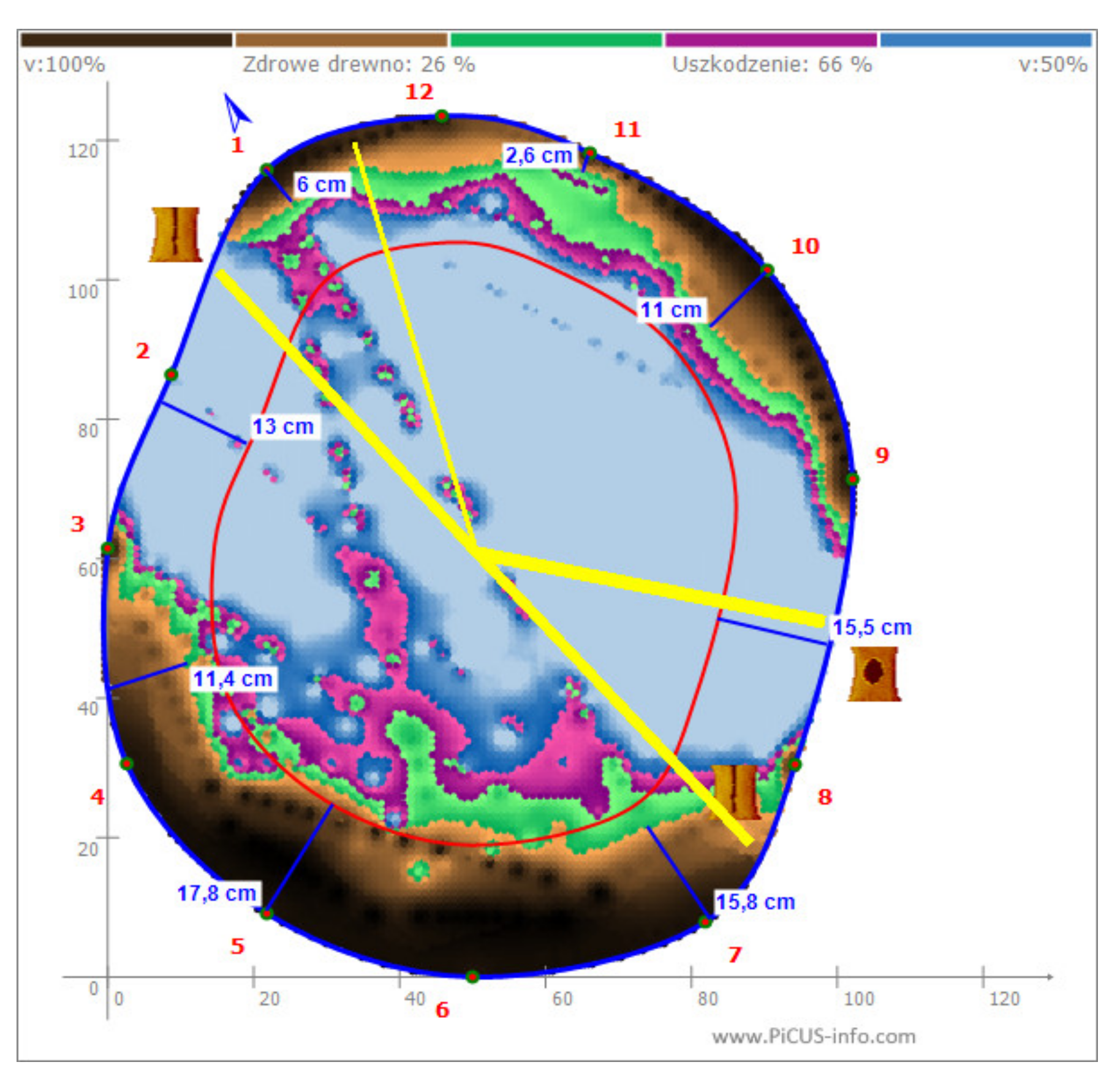
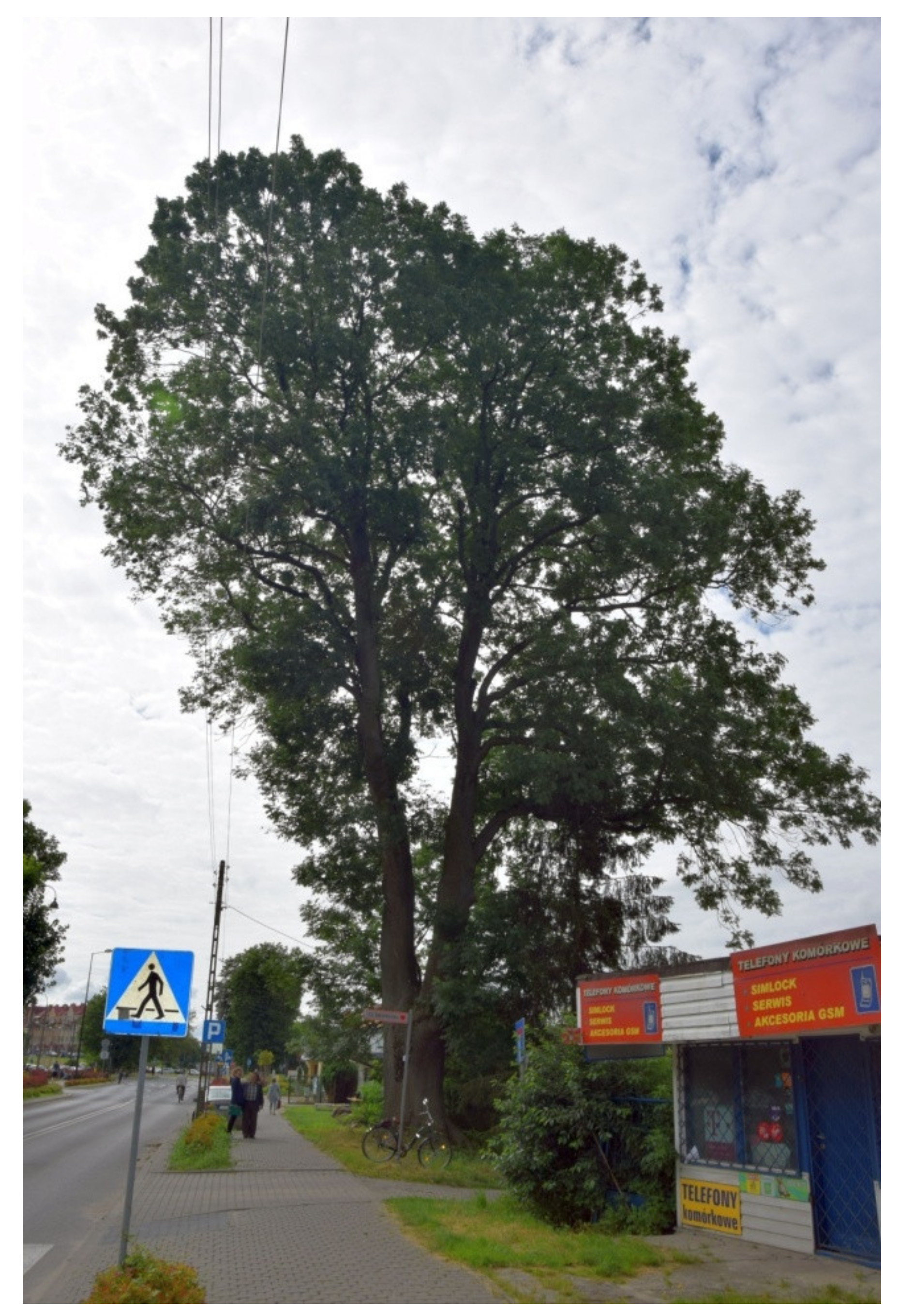

| No. | Species Name | GPS Location | The Circumference of the Trunk at the Height of 1.3 m (cm) | Height (m) | Crown Reach (m) |
|---|---|---|---|---|---|
| 1 | Black poplar (Populus nigra L.) | 51°144′53.387″ N 22°322′16.2166″ E | 476 | 21.8 | 17 |
| 2 | Black poplar (Populus nigra L.) | 51°144′52.999″ N 22°333′33.466″ E | 506 | 16 | 7 |
| 3 | Small-leaved lime (Tilia cordata Mill.) | 50°411′50.76″ N 21°444′15.122″ E | 577 | 19.7 | 15 |
| 4 | Small-leaved lime (Tilia cordata Mill.) | 50°40′37.89″ N 21°44′39.377″ E | 520 | 8.4 | 9.45 |
| 5 | Ash (Fraxinus excelsior L.) | 51°18′7.90″ N 22°53′11.722″ E | 470 | 30.7 | 18.5 |
| No. | Species Name | t/R Ratio | Damaged Wood | Recommendation | Causes of Destruction Likely |
|---|---|---|---|---|---|
| 1 | Black poplar (Populus nigra L.) | 0.29 | 27% | monitoring and cutting in the future | age, soil pollution, air pollution |
| 2 | Black poplar (Populus nigra L.) | 0.28 | 71% | cutting | age, soil pollution, air pollution, groundwater level change |
| 3 | Small-leaved lime (Tilia cordata Mill.) | 0.29 | 61% | cutting | age, soil pollution, air pollution |
| 4 | Small-leaved lime (Tilia cordata Mill.) | 0.17 | 66% | lowering the crown | age, soil pollution, air pollution |
| 5 | Ash (Fraxinus excelsior L.) | 0.3 | 8% | preservation and under protection | age, location near one of the main communication arteries of the city (significant soil and air pollution) |
Publisher’s Note: MDPI stays neutral with regard to jurisdictional claims in published maps and institutional affiliations. |
© 2021 by the authors. Licensee MDPI, Basel, Switzerland. This article is an open access article distributed under the terms and conditions of the Creative Commons Attribution (CC BY) license (https://creativecommons.org/licenses/by/4.0/).
Share and Cite
Dudkiewicz, M.; Durlak, W. Sustainable Management of Very Large Trees with the Use of Acoustic Tomography. Sustainability 2021, 13, 12315. https://doi.org/10.3390/su132112315
Dudkiewicz M, Durlak W. Sustainable Management of Very Large Trees with the Use of Acoustic Tomography. Sustainability. 2021; 13(21):12315. https://doi.org/10.3390/su132112315
Chicago/Turabian StyleDudkiewicz, Margot, and Wojciech Durlak. 2021. "Sustainable Management of Very Large Trees with the Use of Acoustic Tomography" Sustainability 13, no. 21: 12315. https://doi.org/10.3390/su132112315






